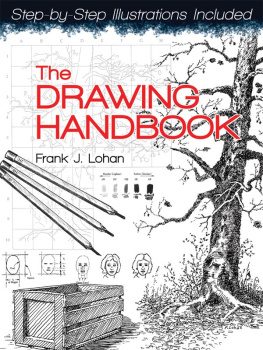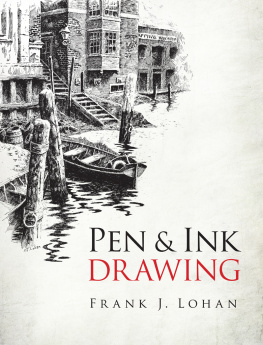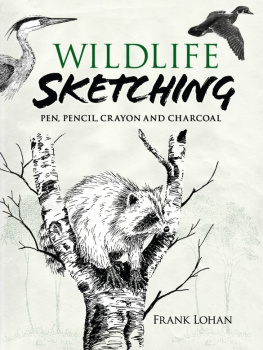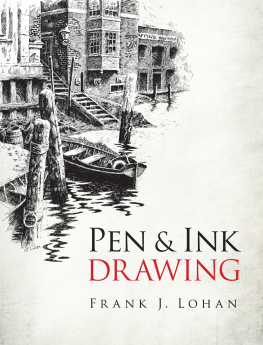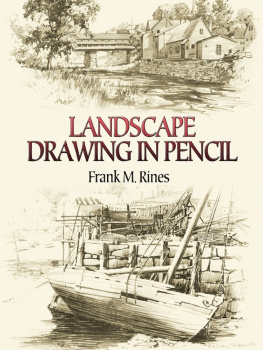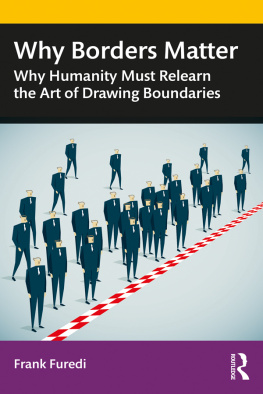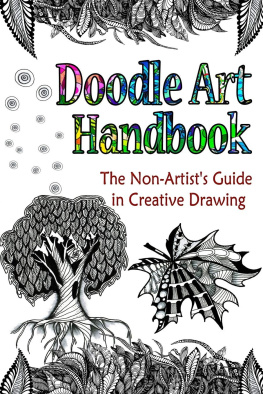Frank J. Lohan - The Drawing Handbook
Here you can read online Frank J. Lohan - The Drawing Handbook full text of the book (entire story) in english for free. Download pdf and epub, get meaning, cover and reviews about this ebook. year: 2013, publisher: Dover Publications, genre: Home and family. Description of the work, (preface) as well as reviews are available. Best literature library LitArk.com created for fans of good reading and offers a wide selection of genres:
Romance novel
Science fiction
Adventure
Detective
Science
History
Home and family
Prose
Art
Politics
Computer
Non-fiction
Religion
Business
Children
Humor
Choose a favorite category and find really read worthwhile books. Enjoy immersion in the world of imagination, feel the emotions of the characters or learn something new for yourself, make an fascinating discovery.
- Book:The Drawing Handbook
- Author:
- Publisher:Dover Publications
- Genre:
- Year:2013
- Rating:4 / 5
- Favourites:Add to favourites
- Your mark:
- 80
- 1
- 2
- 3
- 4
- 5
The Drawing Handbook: summary, description and annotation
We offer to read an annotation, description, summary or preface (depends on what the author of the book "The Drawing Handbook" wrote himself). If you haven't found the necessary information about the book — write in the comments, we will try to find it.
The Drawing Handbook — read online for free the complete book (whole text) full work
Below is the text of the book, divided by pages. System saving the place of the last page read, allows you to conveniently read the book "The Drawing Handbook" online for free, without having to search again every time where you left off. Put a bookmark, and you can go to the page where you finished reading at any time.
Font size:
Interval:
Bookmark:
The
DRAWING
HANDBOOK
Frank J. Lohan

DOVER PUBLICATIONS, INC.
Mineola. New York
Copyright
Copyright 1993 by Frank J. Lohan
All rights reserved.
Bibliographical Note
This Dover edition, first published in 2011, is an unabridged republication of the work originally published in 1993 by Contemporary Books, Chicago.
Library of Congress Cataloging-in-Publication Data
Lohan, Frank J.
The Drawing Handbook / Frank J. Lohan.
p. cm.
This Dover edition, first published in 2011, is an unabridged republication of the work originally published in 1993 by Contemporary Books, Chicago.
Includes bibliographical references and index.
ISBN-13: 978-0-486-48156-2
ISBN-10: 0-486-48156-5
1. Pencil drawingTechnique. 2. Pen drawingTechnique. I. Title.
NC890.L598 2011
741.24dc22
2010047595
Manufactured in the United States by Courier Corporation
48156501
www.doverpublications.com
To Katie ... a real charmer
Contents
Bell Rock, Sedona, Arizona
10 ANIMALS
Drawings are simply two-dimensional arrangements of lines and tones, flat surfaces containing marks and toned areas that represent the essence of what you are trying to say to the viewer. When you produce a drawing or a painting, you create a composition to help convey your impression to others. It does not matter whether your approach is realistic, stylized, or nonrepresentational. The key to all good drawing is a pleasing disposition of lines and tones in your picture area; that is, the key is good composition. Only after your composition is resolved do you consider accuracy of rendition and drawing technique.
This book provides some insight into the basics of composition, shows you some ways to see the geometry of objects, and introduces you to the tools of drawing and shows you how to use them. Then it provides you with practice exercises you can use to try different drawing techniques to create form and dimension with many kinds of subject matter. With proper application of these basics, your work will be better, both in the placement of your picture elements (composition) and in the technical execution of their form and texture.
The camera is considered to be quite literal, showing in a picture just what is actually there. Sometimes, however, it does this with severe distortions. On the other hand, you as an artist can depict the essence of your subject by careful selection and considered arrangement of what you see. These are options not completely available to a photographer. In this sense, arranging does not mean changing what is there as much as it does emphasizing the significant and subordinating the trivial. This is accomplished sometimes through subtle treatment of perspective, interesting division of space, innovative tonal arrangements, and variety of contour. Only after these compositional problems are resolved do you consider the more mechanical factors, such as techniques, which you use to develop the forms by showing the tones and textures of the subject and its setting.
When you see an artist pick up a pen, pencil, or brush and get right to work with little or no apparent forethought, you can be certain he or she has already considered all the compositional and geometric alternatives. To a working artist, this is accomplished almost unconsciously. Only the less-experienced or beginning artist must make these considerations in a more obvious and deliberate manner each time... until doing so becomes second nature.
This handbook contains two parts. introduces you to many of the basics of good composition and shows you how some of the old masters applied these basics in their well-known works. You will learn about the tools of drawingpens, pencils, paper, and erasersand the fundamentals of drawingenlarging and reducing composition drawings, the basics of perspective, and other drawing hints. Then the matter of perceiving the geometry of thingsthe foundation of realistic drawingis considered. Finally, the techniques for creating form and texture with the pen and with the pencil are discussed and illustrated.
provides you with more specific hints on seeing the geometry of different natural things and with the techniques of drawing them with the pencil and with the pen. Step-by-step suggestions are provided for drawing subjects, ranging from landscapes, architecture, and artifacts to the human form, animals, birds, and flowers. I will show you some of the approaches I have learned in forty years of sketching and twenty years of teaching sketching techniques. The drawing exercises present approaches that will help you create more interesting drawings by using variety in your rendition of texture.
Gridded outline compositions are provided with each exercise in ) to assist you in making your own working drawing for each exercise. I believe that this kind of practice allows you to rapidly do more actual drawing. This way you gain more confidence than if you have to first consider the selection of subject matter and then struggle with getting a reasonable composition on paper, all before you can start using the drawing instruments to create form and texture. By copying my drawings for practice, you can quickly gain some dexterity with the pen and with the pencil. You can also begin to stock your mental toolbox with the techniques you will use later in the creation of your own original works.
Technique is the flesh of art, composition is its bones, and vitality is its marrow. This book will help you develop your approach to the flesh and bones. Only you can provide the marrow for your art as you continue your development through frequent practice with subjects of your own choosing.
BASICS
This part of the handbook shows you some of the principle considerations of good composition; introduces you to the tools of drawing; shows you how to copy, reduce, enlarge, and transfer a composition to your final paper; gives you some simplified perspective hints and other things to consider when completing a drawing; explains how you can turn your works into notepaper easily and inexpensively; shows you how to see the geometric basis for natural forms (an essential capability if you want to do realistic drawings on your own); and illustrates some of the techniques of drawing with both the pen and with the pencil , which covers actual drawing exercises.
Composition
There is no single formula for creating well-composed drawings, just as there is no one technique for drawing realistic-looking trees, rocks, or other landscape elements. Awareness of the principles that are covered in this chapter, however, will make you more sensitive to the ways the space on your sheet or canvas can be divided. The application of some of the methods discussed will contribute to better composition in your work. Technique improvement will continue to come as you draw more and more.
Among other things, composition concerns the divisions of space on your pad or canvas and where in these divisions you place your key forms, your center of interest, and the more significant compositional elements. Placement is not everything, however; the tonal relationship among these elements is of equal importance and is part of what makes a composition work.
Any subject matter contains essential, subordinate (less important), and irrelevant features. As an artist you must be concerned with the way placement and tone are used to emphasize the essential and subordinate elements in your rendition of the subject. Irrelevant elements should be eliminated so as not to distract the viewer from the true message of your rendering. Your artistic judgment is called upon when youre deciding whether an element is relevant to your message. For instance, do you keep or eliminate the television antenna on a farmhouse in a landscape? The answer depends on what you are trying to say. Of course, if your message is about the spoiling by careless persons of the rustic beauty of the land, then you include the television antennas, burger wrappers, used tires, and pop cans. If your message is about the beauty of the scene, then you eliminate those elements. With regard to your picture, you are God! You represent your little universe as you want it to be.
Next pageFont size:
Interval:
Bookmark:
Similar books «The Drawing Handbook»
Look at similar books to The Drawing Handbook. We have selected literature similar in name and meaning in the hope of providing readers with more options to find new, interesting, not yet read works.
Discussion, reviews of the book The Drawing Handbook and just readers' own opinions. Leave your comments, write what you think about the work, its meaning or the main characters. Specify what exactly you liked and what you didn't like, and why you think so.

